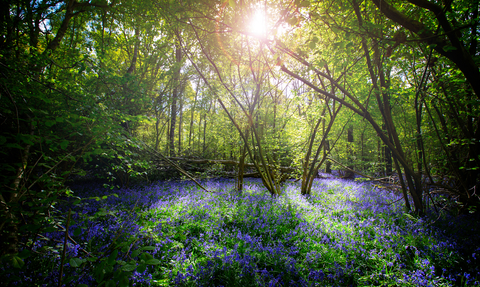
© Jon Hawkins Surrey Hills Photography
Woodlands
With the decline of one third of species that live and rely on woodlands, protecting, improving, and creating woodlands is incredibly important.
Broad-leaved woodland is the natural habitat of Norfolk. It was the principal habitat covering what is now Norfolk since the retreat of the Devensian Glaciation some 12,000 years ago, until Bronze Age people undertook the massive-scale deforestation of the landscape from around 5,000 years ago.
For centuries, until early in the 20th century, people relied on woods for natural resources, both for their own use and for trade. Woods were managed to produce timber for construction, wood for burning and making hurdles, fruit, fungi, forage for livestock, and game for meat and skins.
Woodlands are fantastic habitats for wildlife, supporting specialist woodland species as well as helping a huge range of more generalist wildlife. Woodlands also provide a broad range of wider benefits such as carbon storage and ‘sequestration’ (removing carbon dioxide), flood management, absorption of pollution, and physical and mental human health benefits.
Woodland covers around 13% of the UK – roughly half of this being broad-leaved woodland and half being coniferous plantation. It is essential for the recovery of wildlife, and for the climate, that we protect existing woodlands and plant new areas of woodland in appropriate locations.
There are many different types of woodland, including:
-
Ancient woodland: defined in England as woodland known to have been present since at least 1600. The area of semi-natural ancient woodland is tiny – just 1.2% of the UK. This is a hugely valuable habitat. It is characterised by a range of indicators, typically plant species which are very slow to colonise, such as wood anemone and enchanter’s nightshade.
-
Broad-leaved woodland: woodland in which the trees do not have needles. Instead, they have leaves that are broad. Most of these trees will be deciduous – meaning they lose their leaves in autumn.
-
Wet woodland: woodland with poorly draining or seasonally flooded soils. Typical trees present include willows, birches and alders.
-
Secondary woodland: woodland that has developed through natural processes on land previously cleared of trees. It is usually species-poor compared to ancient woodland.
Native woodlands with trees such as oak, hornbeam, alder, ash, birch and crab apple are an essential part of any countryside as they contain and support a myriad of plant, lichen, fungi, invertebrate, animal and bird species. The oak tree alone can be home to up to 2,300 species.
Useful links
| General woodland information | The Wildlife Trusts woodland habitat page that gives an overview of woodland types, a history of woodlands and conservation and threats. | Woodland - The Wildlife Trusts |
| Woodlands for wildlife | Advice on designing and planting a new woodland to maximise benefits for wildlife. | Woodlands for Wildlife - Norfolk Wildlife Trust |
| History of woodlands | The Conservation Volunteers' brief history of woodlands in Britain including details on historical clearnace and management of woodlands. | A brief history of woodlands in Britain - TCV |
| Surveying a woodland | Advice on how to survey a woodland and its wildlife, which will help to form the basis of a plan for the wood's management. | Rapid Woodland Assessment – Community survey form |
| Tree planting | Warwickshire Wildlife Trust have created a flow chart and infographic to guide you through if and where it is best to plant trees. | Tree planting guidance - Warwickshire Wildlife Trust |
| Managing a woodland | The Widlife Trusts guide on woodland management for wildlife from coppicing to thinning, dead wood and more. | How to manage a woodland for wildlife - The Wildlife Trusts |
| Possible funding options | Government guidance and support on woodland creation in England, including funding to create woodland, legal requirements and best practice for sustainability. | Tree planting and woodland creation - GOV.UK |
